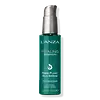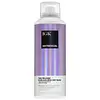What's inside
What's inside
 Key Ingredients
Key Ingredients

 Benefits
Benefits

 Concerns
Concerns

 Ingredients Side-by-side
Ingredients Side-by-side

Cyclopentasiloxane
EmollientDimethicone
EmollientCaprylyl Methicone
Skin ConditioningDiphenylsiloxy Phenyl Trimethicone
Skin ConditioningPerfluorononyl Dimethicone
Skin ConditioningMelia Azadirachta Extract
Skin ConditioningKeratin Amino Acids
Skin ConditioningSantalum Album Extract
CleansingPhellodendron Amurense Bark Extract
Skin ConditioningHordeum Distichon Extract
Skin ProtectingDimethiconol Cysteine
Ceramide NP
Skin ConditioningSodium Hyaluronate
HumectantDimethicone PEG-8 Meadowfoamate
EmollientSodium PCA
HumectantZinc PCA
HumectantMagnesium PCA
HumectantManganese PCA
HumectantCitrus Limon Fruit Extract
MaskingFumaria Officinalis Flower/Leaf/Stem Extract
Skin ConditioningHelianthus Annuus Seed Oil
EmollientSqualane
EmollientFumaric Acid
BufferingEthylhexyl Methoxycinnamate
UV AbsorberTetrahexyldecyl Ascorbate
AntioxidantTrimethylsiloxyamodimethicone
Ascorbyl Methylsilanol Pectinate
AntioxidantButylene Glycol
HumectantWater
Skin ConditioningBenzotriazolyl Dodecyl P-Cresol
UV AbsorberParfum
MaskingAlpha-Isomethyl Ionone
PerfumingBenzyl Salicylate
PerfumingButylphenyl Methylpropional
PerfumingCitronellol
PerfumingCoumarin
PerfumingGeraniol
PerfumingLimonene
PerfumingLinalool
PerfumingCyclopentasiloxane, Dimethicone, Caprylyl Methicone, Diphenylsiloxy Phenyl Trimethicone, Perfluorononyl Dimethicone, Melia Azadirachta Extract, Keratin Amino Acids, Santalum Album Extract, Phellodendron Amurense Bark Extract, Hordeum Distichon Extract, Dimethiconol Cysteine, Ceramide NP, Sodium Hyaluronate, Dimethicone PEG-8 Meadowfoamate, Sodium PCA, Zinc PCA, Magnesium PCA, Manganese PCA, Citrus Limon Fruit Extract, Fumaria Officinalis Flower/Leaf/Stem Extract, Helianthus Annuus Seed Oil, Squalane, Fumaric Acid, Ethylhexyl Methoxycinnamate, Tetrahexyldecyl Ascorbate, Trimethylsiloxyamodimethicone, Ascorbyl Methylsilanol Pectinate, Butylene Glycol, Water, Benzotriazolyl Dodecyl P-Cresol, Parfum, Alpha-Isomethyl Ionone, Benzyl Salicylate, Butylphenyl Methylpropional, Citronellol, Coumarin, Geraniol, Limonene, Linalool
Dimethyl Ether
SolventWater
Skin ConditioningDicaprylyl Carbonate
EmollientDisiloxane
Skin ConditioningDimethicone
EmollientSr-Spider Polypeptide-1
Skin ProtectingOzokerite
Emulsion StabilisingLavandula Angustifolia Oil
MaskingPEG-40 Hydrogenated Castor Oil
EmulsifyingHydrolyzed Pea Protein
EmollientCystine Bis-Pg-Propyl Silanetriol
Skin ConditioningHydroxyethyl Behenamidopropyl Dimonium Chloride
Dimethicone/Vinyl Dimethicone Crosspolymer
Skin ConditioningTrimethylsiloxyamodimethicone
Ethylhexyl Methoxycinnamate
UV AbsorberC11-15 Pareth-7
EmulsifyingC12-16 Pareth-9
EmulsifyingTrideceth-12
EmulsifyingPhenyl Trimethicone
Skin ConditioningGlycerin
HumectantButylene Glycol
HumectantCaprylyl Glycol
EmollientEthylhexylglycerin
Skin ConditioningHexylene Glycol
EmulsifyingBHT
Antioxidant1,2-Hexanediol
Skin ConditioningPhenoxyethanol
PreservativeParfum
MaskingBenzyl Salicylate
PerfumingLinalool
PerfumingButylphenyl Methylpropional
PerfumingCoumarin
PerfumingLimonene
PerfumingDimethyl Ether, Water, Dicaprylyl Carbonate, Disiloxane, Dimethicone, Sr-Spider Polypeptide-1, Ozokerite, Lavandula Angustifolia Oil, PEG-40 Hydrogenated Castor Oil, Hydrolyzed Pea Protein, Cystine Bis-Pg-Propyl Silanetriol, Hydroxyethyl Behenamidopropyl Dimonium Chloride, Dimethicone/Vinyl Dimethicone Crosspolymer, Trimethylsiloxyamodimethicone, Ethylhexyl Methoxycinnamate, C11-15 Pareth-7, C12-16 Pareth-9, Trideceth-12, Phenyl Trimethicone, Glycerin, Butylene Glycol, Caprylyl Glycol, Ethylhexylglycerin, Hexylene Glycol, BHT, 1,2-Hexanediol, Phenoxyethanol, Parfum, Benzyl Salicylate, Linalool, Butylphenyl Methylpropional, Coumarin, Limonene
Ingredients Explained
These ingredients are found in both products.
Ingredients higher up in an ingredient list are typically present in a larger amount.
Benzyl Salicylate is a solvent and fragrance additive. It is an ester of benzyl alcohol and salicylic acid. This ingredient can be naturally found in some plants and plant extracts.
In fragrances, Benzyl Salicylate may be a solvent or a fragrance component. In synthetic musk scents, it is used as a solvent. For floral fragrances such as lilac and jasmine, it is used as a fragrance component. The natural scent of Benzyl Salicylate is described as "lightly-sweet, slightly balsamic".
While Benzyl Salicylate has been associated with contact dermatitis and allergies, emerging studies show it may not be caused by this ingredient alone.
However, this ingredient is often used with fragrances and other components that may cause allergies. It is still listed as a known allergen in the EU. We recommend speaking with a professional if you have concerns.
Another study from 2021 shows Benzyl Salicylate may have anti-inflammatory properties.
Learn more about Benzyl SalicylateButylene Glycol (or BG) is used within cosmetic products for a few different reasons:
Overall, Butylene Glycol is a safe and well-rounded ingredient that works well with other ingredients.
Though this ingredient works well with most skin types, some people with sensitive skin may experience a reaction such as allergic rashes, closed comedones, or itchiness.
Learn more about Butylene GlycolButylphenyl Methylpropional is a synthetic fragrance. You might know it as "lilial". The scent of this ingredient is floral-like and similar to the scent of lily flowers.
In March of 2022, the EU banned this ingredient in both rinse-off and leave-on products. This is because research found Butylphenyl Methylpropional to disrupt fertility in rats.
This ingredient is also a known EU allergen, meaning it is likely to cause an allergic reaction. Irritated skin can be damaging.
We always recommend speaking with a professional if you have any concerns or questions about this ingredient.
Learn more about Butylphenyl MethylpropionalCoumarins are a group of substances found naturally in plants. There are over 1300 types of coumarins identified. It has a natural vanilla scent.
Coumarin is an identified EU known allergy, meaning it may cause an allergic reaction when applied to the skin.
In many countries, coumarin is banned as a food additive. However, it can be found in soaps, tobacco products, and some alcohol drinks.
Plants use coumarins as a chemical defense. Some plants that have coumarins include lavender, tonka beans, and yellow clovers.
Learn more about CoumarinDimethicone is a type of synthetic silicone created from natural materials such as quartz.
What it does:
Dimethicone comes in different viscosities:
Depending on the viscosity, dimethicone has different properties.
Ingredients lists don't always show which type is used, so we recommend reaching out to the brand if you have questions about the viscosity.
This ingredient is unlikely to cause irritation because it does not get absorbed into skin. However, people with silicone allergies should be careful about using this ingredient.
Note: Dimethicone may contribute to pilling. This is because it is not oil or water soluble, so pilling may occur when layered with products. When mixed with heavy oils in a formula, the outcome is also quite greasy.
Learn more about DimethiconeEthylhexyl Methoxycinnamate is an organic compound that provides UVB protection. It often goes by the more common name of octinoxate. It is created from methoxycinnamic acid and 2-ethylhexanol.
Ethylhexyl Methoxycinnamate absorbs UVB rays with wavelengths between 280-320 nm. UV absorbers protect your skin by using chemical reactions to convert UV rays into heat and energy.
UVB (290-320 nm) rays emit more energy than UVA rays. They are capable of damaging DNA, causing sunburns and are thought to be linked to skin cancer.
The state of Hawaii has banned sunscreens containing octinoxate due to its potential impact on coral reefs. More research is needed to bridge gaps in this research. The European Union allows higher levels of octinoxate in sunscreens than the US and Australia.
Ethylhexyl Methoxycinnamate is oil soluble. It is not stable and may lose efficacy when exposed to sunlight.
Learn more about Ethylhexyl MethoxycinnamateLimonene is a fragrance that adds scent and taste to a formulation.
It's found in the peel oil of citrus fruits and other plants such as lavender and eucalyptus. The scent of limonene is generally described as "sweet citrus".
Limonene acts as an antioxidant, meaning it helps neutralize free radicals.
When exposed to air, oxidized limonene may sensitize the skin. Because of this, limonene is often avoided by people with sensitive skin.
The term 'fragrance' is not regulated in many countries. In many cases, it is up to the brand to define this term. For instance, many brands choose to label themselves as "fragrance-free" because they are not using synthetic fragrances. However, their products may still contain ingredients such as essential oils that are considered a fragrance.
Learn more about LimoneneLinalool is a fragrance and helps add scent to products. It's derived from common plants such as cinnamon, mint, citrus, and lavender.
Like Limonene, this ingredient oxidizes when exposed to air. Oxidized linalool can cause allergies and skin sensitivity.
This ingredient has a scent that is floral, spicy tropical, and citrus-like.
Learn more about LinaloolParfum is a catch-all term for an ingredient or more that is used to give a scent to products.
Also called "fragrance", this ingredient can be a blend of hundreds of chemicals or plant oils. This means every product with "fragrance" or "parfum" in the ingredients list is a different mixture.
For instance, Habanolide is a proprietary trade name for a specific aroma chemical. When used as a fragrance ingredient in cosmetics, most aroma chemicals fall under the broad labeling category of “FRAGRANCE” or “PARFUM” according to EU and US regulations.
The term 'parfum' or 'fragrance' is not regulated in many countries. In many cases, it is up to the brand to define this term.
For instance, many brands choose to label themselves as "fragrance-free" because they are not using synthetic fragrances. However, their products may still contain ingredients such as essential oils that are considered a fragrance by INCI standards.
One example is Calendula flower extract. Calendula is an essential oil that still imparts a scent or 'fragrance'.
Depending on the blend, the ingredients in the mixture can cause allergies and sensitivities on the skin. Some ingredients that are known EU allergens include linalool and citronellol.
Parfum can also be used to mask or cover an unpleasant scent.
The bottom line is: not all fragrances/parfum/ingredients are created equally. If you are worried about fragrances, we recommend taking a closer look at an ingredient. And of course, we always recommend speaking with a professional.
Learn more about ParfumTrimethylsiloxyamodimethicone (don't worry, we cannot pronounce this either) is a siloxane polymer. Siloxane polymers are widely used as antimicrobials and texture enhancer. This ingredient is synthetically created.
As a silicone, Trimethylsiloxyamodimethicone helps hydrate and smooth the skin. It can also be found in hair care products.
Trimethylsiloxyamodimethicone is described as "non-greasy" and "silky".
Learn more about TrimethylsiloxyamodimethiconeWater. It's the most common cosmetic ingredient of all. You'll usually see it at the top of ingredient lists, meaning that it makes up the largest part of the product.
So why is it so popular? Water most often acts as a solvent - this means that it helps dissolve other ingredients into the formulation.
You'll also recognize water as that liquid we all need to stay alive. If you see this, drink a glass of water. Stay hydrated!
Learn more about Water